

“When allowed to design a low-density modern residential community in Lin'an, the birthplace of Wu-Yue culture, the aim was to address the fundamental needs of contemporary living. Through the intersection of modernity and Chineseness, we sought to reflect on the evolving relationship between lifestyle progression and cultural heritage.”
— Zhu Peidong

Project Name: Zhongtian · Jing Yue Qing Lan "Multicolor Villa"
Architectural and Landscape Design: line+ studio
Website: www.lineplus.studio
Contanct: pr@lineplus.studio
Chief Architect/Project Principal: Zhu Peidong
Design Team: Sun Xiaoyu, Cai Xianghang, Deng Chao, Sun Jin, Zhou Yang, Zhang Qunchen, Du Mengying (Architecture); Li Shangyang, Lu Yuping, Luo Xiaoxia, Jin Jianbo, Zhang Wenjie (Landscape)
Client: ZHONGTIAN MYHOME GROUP
Interior Design: Dejoy International Architects (DIA)
Facade Design: Hangzhou Zhongchuang United Architectural Technology Co., Ltd.
Location: Zhejiang, Hangzhou
Building Area: 1,871 m²
Design Period: 2023.07-2024.01
Construction Period: 2023.12-2024.06
Structure: Reinforced Concrete
Materials: Aluminum, Glass, Stone, Porcelain Pipe
Photography: Zhang Dengxing, line+
Over the past two decades, contemporary Chinese residential architecture has evolved through various phases, beginning with foreign influences, moving through rapid turnover and homogenization, and culminating in a new "Chinese-style" housing that responds to traditional architectural culture. However, driven by market forces, "Chinese-style" has increasingly become a generalized symbol, detached from regional and cultural contexts, and more focused on the demands of property buyers. It is both an architectural style and a reflection of modern people's nostalgia for traditional living.
As the commercialization of Chinese-style homes progressed, their associated symbols became formulaic, giving rise to various iterations. Among them, the "Song style," inspired by the imperial architecture of the Song dynasty, has gained prominence for its simplicity and lightness. This version of Song-inspired architecture, driven by both commercial and design influences, has become one of the latest trends.

Jing Yue Qing Lan is located in the Qingshan Lake area of Lin'an, Hangzhou. Lin'an, the birthplace of King Qian Liu of the Wu-Yue Kingdom, holds significant historical importance as the cradle of Wu-Yue culture and the foundation of ancient Hangzhou’s prosperity during the Song dynasty. As early as the 2000s, the local government set a strategic goal to develop Lin'an into a city of Wu-Yue culture, thereby imposing specific architectural style requirements for the region. When Zhongtian Myhome Group invited us to design the project, a clear stylistic direction was provided: Chinese-style, Song-inspired.

During our site survey, we noted that recent residential developments in Lin'an, influenced by "Chinese-style" aesthetics, primarily catered to retirees and vacationers seeking a suburban lifestyle. However, they conveyed a somber, outdated atmosphere, creating a mismatch with younger buyers attracted by nearby tech-driven industrial parks and academic institutions. This presented a challenge: how to align the design with regional identity while meeting the evolving needs of the new population.

Through our case studies, the team found that most "Chinese-style" designs—whether broadly conceived or specifically inspired by Song aesthetics—tended to focus primarily on form. Some designs perpetuated the use of symbolic elements from traditional architecture, while others sought formal refinement based on classical texts like The Manual of Architecture. Despite their merits, these approaches remained fundamentally imitative, rooted in the replication and transformation of ancient architectural practices.

Faced with the client's demand for a new generation of residential products and the government's goal of promoting Song dynasty heritage, we sought an innovative approach to "Song style." This approach aimed to bridge traditional Song aesthetics with modern living, drawing inspiration from the realism of Song landscape paintings. By analyzing their composition, imagery, and spiritual essence, we aimed to capture and translate the cultural and aesthetic spirit of the Song dynasty into the design.

01
Rooted in Painting, Rendered by Building
— A Modern Interpretation of Chineseness
In the famous Autumn Scenery of Rivers and Mountains by Zhao Boju, distant mountains and rolling hills are adorned with pavilions, waterfalls, and bamboo-lined paths. This depiction of architecture in harmony with nature, featuring bridges and flowing water, illustrates a layout that responds organically to the environment. The painting reflects ideals of tranquillity and harmony while showcasing the bold use of color typical of Song-era art.
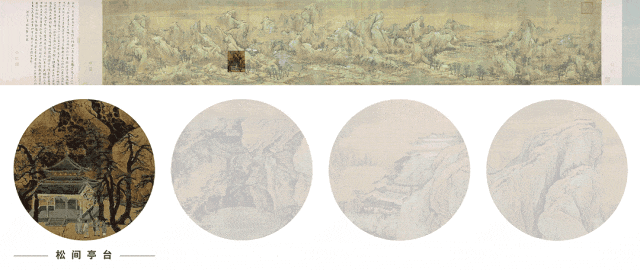 △ Analysis of the Scene Elements in the Painting
△ Analysis of the Scene Elements in the Painting

Rendered with meticulous traditional techniques, the painting unfolds as a horizontal scroll, creating depth through the interplay of foreground, middle ground, and background. The foreground depicts trees and boats along the riverbank, the middle ground highlights rugged mountains and scattered villages, while mist-shrouded peaks in the distance evoke a serene, poetic atmosphere.

Inspired by this expansive and intricate painting, its immersive landscape was translated into a built environment. The layered perspectives were adapted into architecture, with the distant mountains and lakes of Lin'an forming the backdrop, courtyard waterfalls and village-like settlements in the middle ground, and rocky landscapes in the foreground.



Entering the public space, key elements from the painting—such as mountains, waterfalls, pavilions, and pine trees—were reinterpreted as architectural features, including the base, facades, roofs, and landscaping. In this way, the building becomes painting: by transforming spatial elements, a "living, walkable landscape" was created, inviting visitors to immerse in the scene. The interplay of path, perspective, and environment allows art and architecture to converge seamlessly.

△ Correspondence Between the Painting and the Scene


In the courtyard, the technique of scattered perspective transforms the space as one move through it. Overlapping mountain rocks, cascading waterfalls, and pavilions emerge through the mist, not only translating the visual narrative into physical experience but also evoking the sensation of inhabiting a living landscape painting.


“Chineseness" is not merely conveyed through form, but through the recreation of a spatial atmosphere that encapsulates the essence of traditional poetic dwelling.

02
Song Aesthetics in Modern Construction
— A Dialogue between Modernity and Tradition
The mass and facade treatment of the villas departs from traditional approaches, focusing on the core of contemporary living. Natural light, views, courtyards, and terraces are central to the design, maximizing outdoor space while prioritizing privacy and enhancing the residential experience. The aim was to create adaptable living environments that meet modern ecological needs.
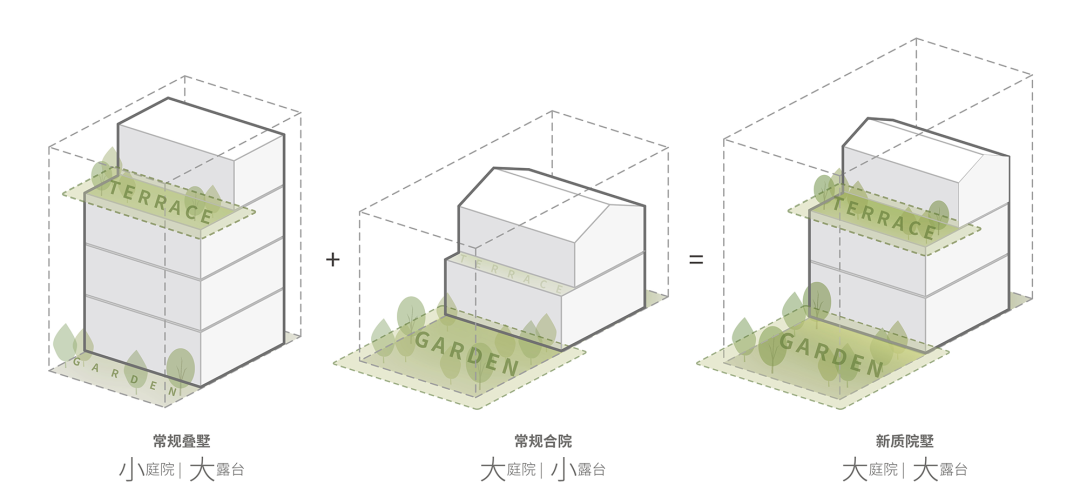 △ Analysis of the Villa Massing
△ Analysis of the Villa Massing
The facade balances light, landscape, and privacy. Large floor-to-ceiling windows frame south-facing views, while smaller openings on the north side ensure privacy. Functional spaces, such as staircases and secondary bathrooms, are strategically placed to minimize window openings and further reinforce seclusion.


Drawing from the depiction of figures in Song dynasty paintings, we translated their spatial imagery into architectural elements. These were realized as multi-level, elevated platforms, enhancing the semi-outdoor courtyard experience while fostering a diverse, tranquil environment suited for modern living.
 △ Analysis and Transformation of Spatial Imagery in Song Paintings
△ Analysis and Transformation of Spatial Imagery in Song Paintings

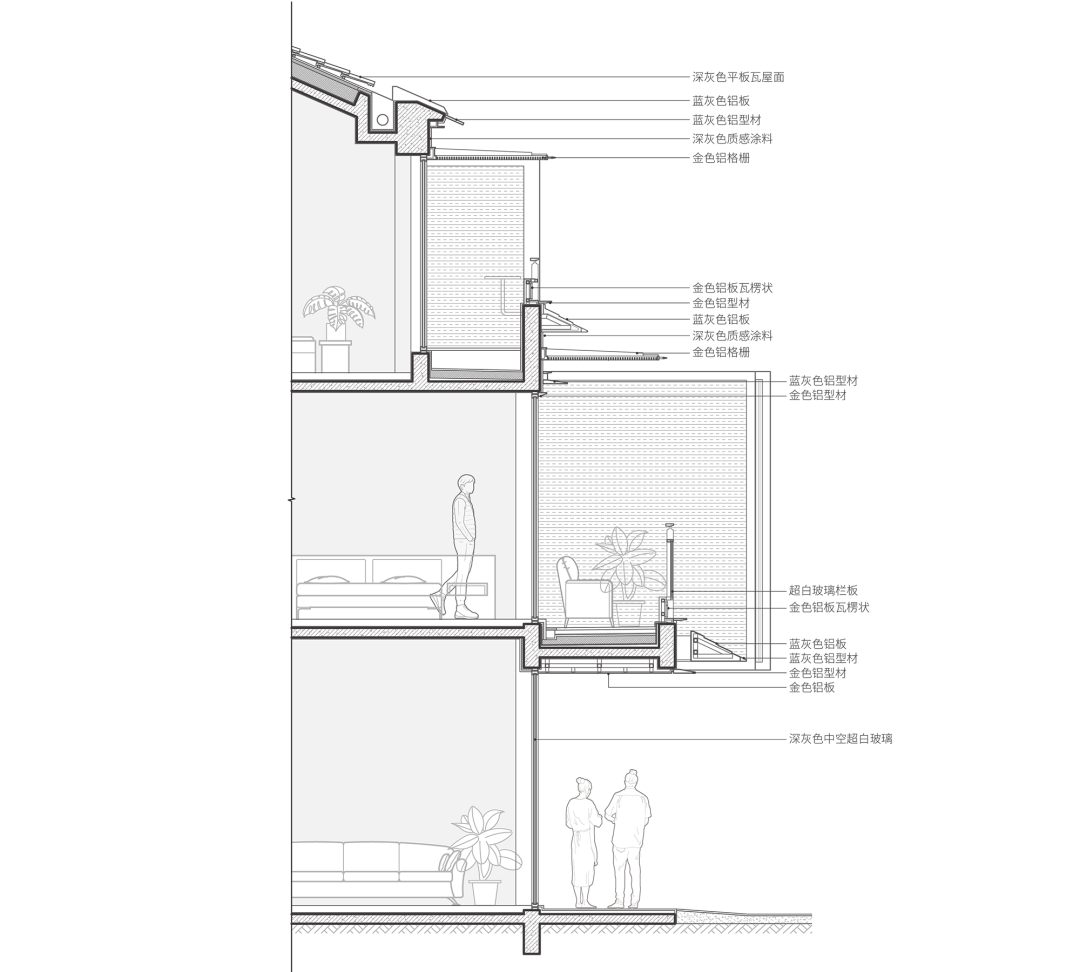 △ Wall Section Details
△ Wall Section DetailsThe roof, a hallmark of "Song-style" architecture, deviates from the traditional gable roofs of Southern Chinese vernacular dwellings. Instead, we integrated a dual-pitched roof with a metal grille, addressing modern needs for sunshade and rain protection while incorporating traditional design motifs. The roof's varied orientations create a collective image that echoes the dense, layered character of traditional village settlements.
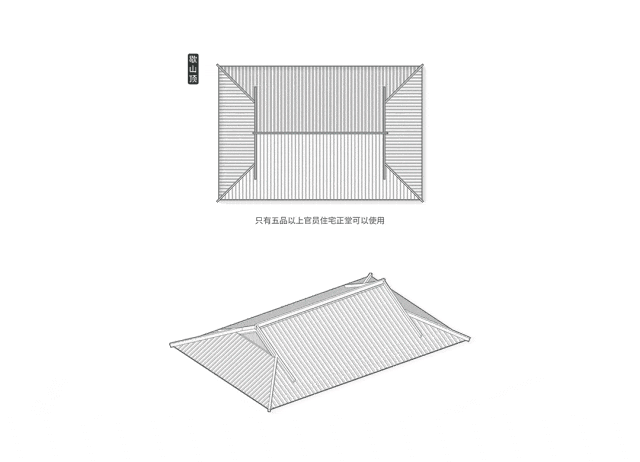 △ Roof Generation
△ Roof Generation


△ Roof Grille Eaves

△ Comparison of Grille Batten Dimensions
03
Song Aesthetics and Materiality
— Expression of Differentiated Texture
Song dynasty paintings draw their colors from nature, using mineral pigments and natural extracts to create subtle tonal layers and rich variations. Blue, green, and yellow hues are prominently featured, with gradual transitions that build depth and atmosphere. These colors were abstracted to form the "Five Colors of Song," using stone, metal, wood, porcelain, and tile as core materials. Built on a foundation of deep gray, the project integrates these colors in a classic 6:3:1 ratio, extending from the facade to the smallest design details.
 △ Analysis of the Concept of "Five Colors of Song"
△ Analysis of the Concept of "Five Colors of Song"
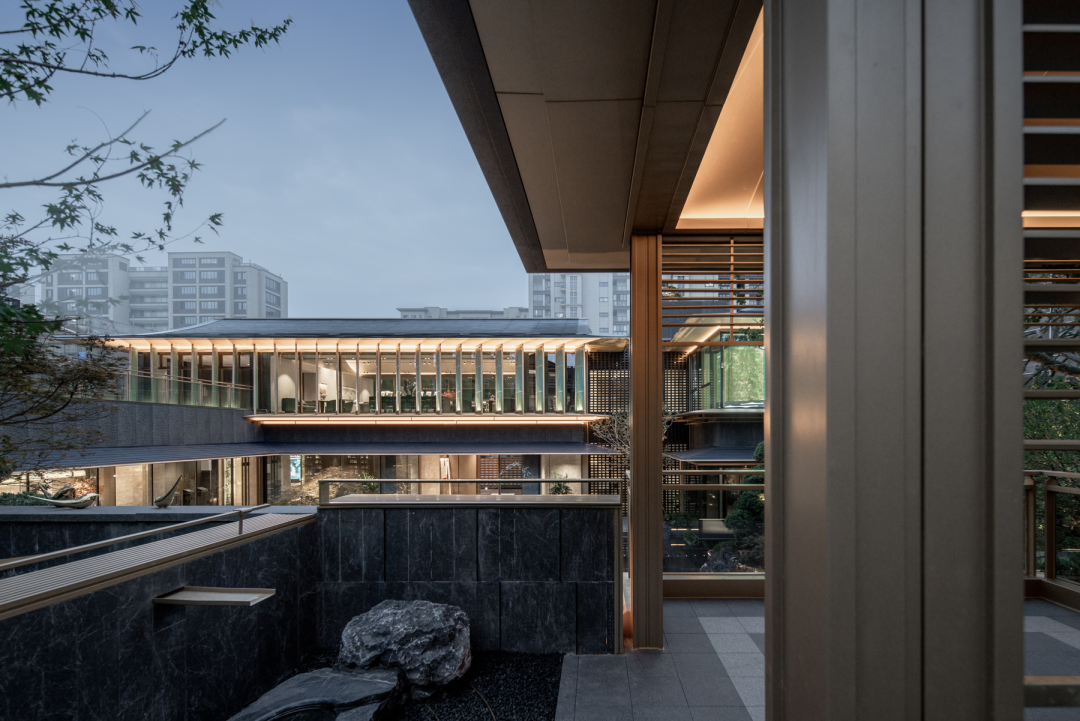

 △ Color Analysis of the Public Space Facade
△ Color Analysis of the Public Space Facade

Porcelain, a hallmark material of the Song dynasty, is increasingly used in contemporary architecture and interiors. In this design, large-scale porcelain pipes were assembled on the facade to create a grille-like screen, complemented by slanted aluminum panels to enhance the visual effect.



The selected celadon porcelain pipes, refined through multiple material tests, maintain the elegance and tactile quality of traditional celadon. Under natural light, they emit a soft, warm glow. Gold accents subtly embedded in the details further enhance the visual depth and refinement.


Stone was selected for its rugged, natural texture. After multiple rounds of material testing, we opted for a surface treatment that closely mirrors the raw, tactile quality of natural mountain stone, emphasizing its organic roughness.


The wood material, chosen for its durability and fire resistance, is represented by hand-painted aluminum panels that imitate the texture of the natural wood grain. This technique ensures a high level of authenticity in the wood's appearance.

△ Construction Process of Faux Wood Grain Coating


Blue-glazed tiles, inspired by Song dynasty imperial architecture, contrast sharply with other materials. Viewed from above, these indigo tiles create a unified visual impression, recalling the aesthetics of Song paintings while defining a modern residential landscape.

The Song dynasty’s architectural achievements are celebrated for their exquisite craftsmanship, highlighting the subtlety of structure and detail. In the design, the precision of the facade and structural design integrates contemporary materials with intricate craftsmanship, creating a dialogue between traditional aesthetics and modern living, while enhancing the spatial experience both visually and tactilely.
 △ Public Space Wall Section Details
△ Public Space Wall Section Details

The villa facades primarily use stone, aluminum, and glass, complemented by faux wood grain finishes and embedded foam ceramic lines. Wood-inspired elements further enrich the architectural layers, adding depth and a sense of quality to the overall structure.




04
A New Interpretation of Song Aesthetics,
Reviving the Ancient in the Modern
The aesthetic principles of "vastness" and "simplicity" in Song dynasty aesthetics resonate with contemporary desires for harmony with nature and a tranquil lifestyle. The Song dynasty, a pinnacle of Chinese culture, offers rich, unrestrained expression that inspires contemporary architecture. Embracing new technologies and evolving aesthetics, we seek to transcend formal constraints and create a "Song-style" architecture that bridges tradition and modernity. Jing Yue Qing Lan "Multicolor Villa" facilitates this dialogue with history, prompting a reconsideration of traditional living. The design fosters a space that invites reflection on the deeper essence of daily life.

 △ Site Plan
△ Site Plan
 △ Ground Floor Plan of Public Space
△ Ground Floor Plan of Public Space
 △ Second Floor Plan of Public Space
△ Second Floor Plan of Public Space
 △ Public Space Elevation
△ Public Space Elevation
 △ Public Space Elevation
△ Public Space Elevation

